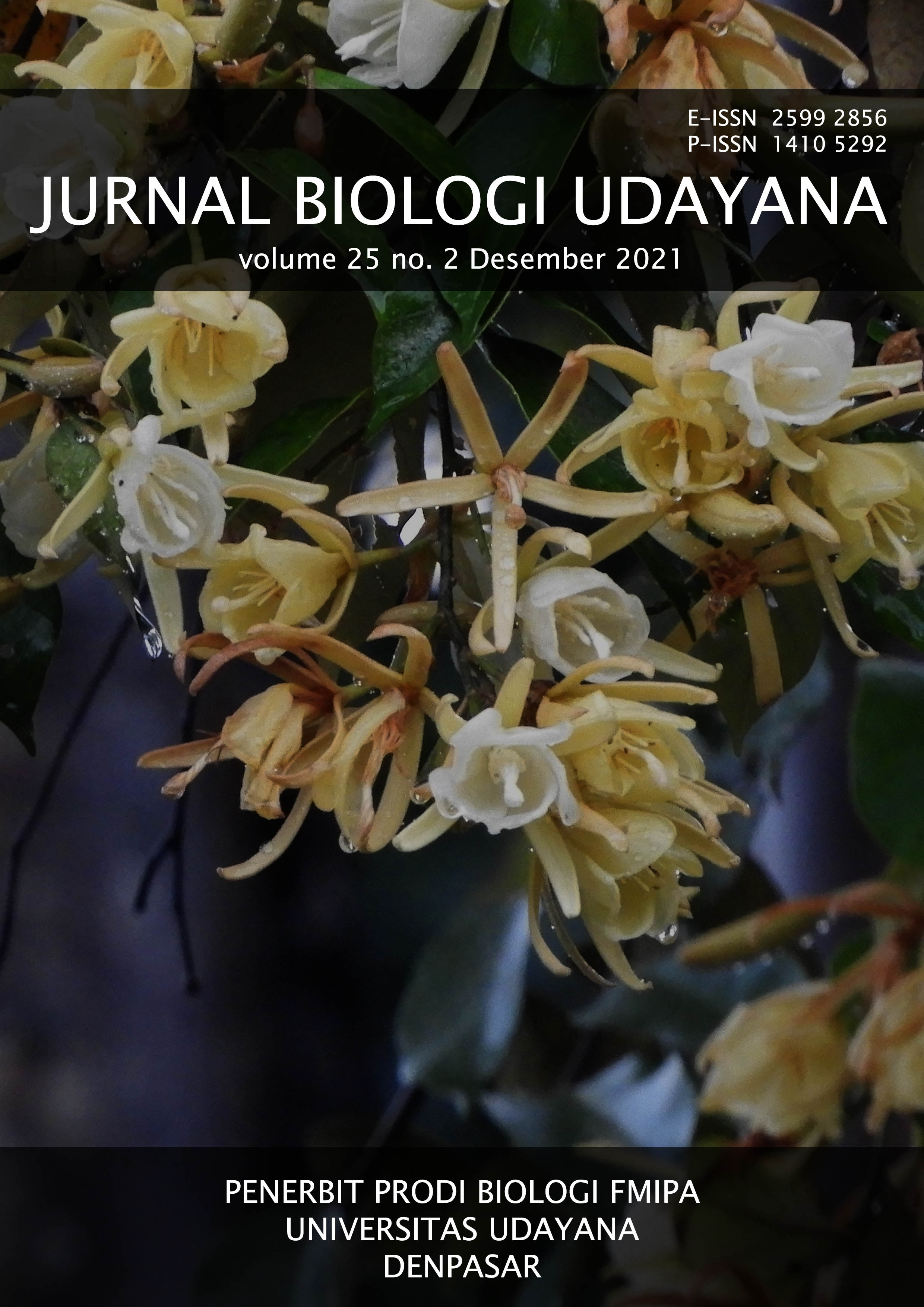Potential Rhizopus spp. in control the growth of Aspergillus flavus FNCC6109 in broiler chicken concentrate feed
Abstract
Aspergillus flavus contamination of agriculture in Indonesia can cause problems to animal health and productivity. Some factors can support the appearance of contamination in feed, especially temperature and humidity. The main objective of this research was to investigate potency of Rhizopus spp. on inhibit A. flavus FNCC6109 in broiler chicken concentrate feed. The experiments were conducted dual culture method and the inhibition test of the Rhizopus spp. filtrate culture was incubated for 3, 4 and 5 days on in vitro. The in vivo test was directly applied in broiler chicken concentrate feed which added Rhizopus spp. filtrate culture concentration at 10% (v/v), 20% (v/v), 30% (v/v), 40% (v/v), dan 50% (v/v). The results showed that the Rhizopus spp. filtrate culture significantly (P?0,05) to inhibit the growth of A. flavus FNCC6109 both in vitro and in vivo. The percentage inhibition of Rhizopus spp. filtrate culture incubated for 5 days showed 67,47±2,10% relatively better results than 3 and 4 days, and therefore was used in the in vivo. Application of 50% (v/v) Rhizopus spp. filtrate culture to the broiler chicken concentrate feed significantly reduced 82% population of A. flavus FNCC6109 after 15 days incubated relative to that of negative control (concentrate feed without addition Rhizopus spp. filtrate culture and A. flavus FNCC6109).
Downloads
References
Bidura IGNG. 2017. Buku Ajar Teknologi dalam Industri Pakan. Denpasar: Udayana University Press.
Budiarti SW, Widyastuti SM. 2011. Aktivitas Antifungal β-1,3-Glukanase Trichoderma reesei pada Fungi Akar Ganoderma philipii. Jurnal Widyariset 14(2):455-460.
Celestino KRS, Cunha RB, Felix CR. 2006. Characterization of a β-glucanase Produced by Rhizopus microspores var. microspores, and its Potensial for Application in The Brewing Industry. Journal BMC Biochemistry 7(23):1-9.
Darmayasa IBG. 2015. Potensi Trichoderma asperellum TKD Dalam Menghambat Pertumbuhan Aspergillus flavus FNCC6109 Sebagai Upaya Mengurangi Cemaran Afkatoksin B1 Pada Model Konsentrat. Doctoral Disertasi. Universitas Udayana.
Deacon JW. 1997. Modern Mycology. 3rd ed. Oxford: Balckwell Science Ltd.
Didwania N, Joshi M. 2013. Mycotoxins: A Critical Review on Occurrence and Significance. Int J Pharm. Pharm Sci. 5: 1014-1019.
Endrawati D, Kusumaningtyas E. 2017. Beberapa Fungsi Rhizopus sp. dalam Meningkatkan Nilai Nutrisi Bahan Pakan. WARTAZOA 27(2): 81-88
Fadilah R, Polana A. 2011. Mengatasi 71 Penyakit Pada Ayam. Jakarta: Agromedia Pustaka.
Gandjar I, Samson RA, Vermeulen KVDT, Oetari A, Santoso I. 1999. Pengenalan Kapang Tropik Umum. Jakarta: Yayasan Obor Indonesia.
Ghiasian SA, Maghsood AH. 2011. Occurrence of Aflatoxigenic Fungi in Cow Feeds During the Summer and Winter Season in Hamadan, Iran. African Journal of Microbiology Research 5(5): 516-521.
Hackbart HCS, Machado AR, Christ-Ribeiro A, Prietto L, Badiale-Furlong E. 2014. Reduction of Aflatoxins by Rhizopus oryzae and Trichoderma reesei. Mycotoxin Res. 30: 141-149.
Hasanah U. 2017. Mengenal Aspergillosis, Infeksi Jamur Genus Aspergillus. Jurnal Keluarga Sehat Sejahtera 15(30): 76-86.
Hedayati MT, Pasqualloto AC, Warn PA, Bowyer P, Denning DW. 2007. Aspergillus flavus: human pathogen, allergen and mycotoxin producer. Journal of Microbial 153(1): 1677-1692.
Hjeljord L, Tronsmo A. 1998. Trichoderma and Gliocladium in Biological Control: an overview. In G.E. Harman and C.P. Kubicek (Eds.), Trichoderma and Gliocladium Vol. 2. London: Taylor and Francis.
Ilyas M, Rahmansyah M, Kanti A. 2006. Seri Panduan: Teknik Isolasi Fungi. Jakarta: LIPI Press.
Kobayasi. S. Y., N. Okazaki, dan T. Koseki. 1992. Purification and Characterization of an Antibiotic Substance Producred from Rhizopus oligosporus IFO 8631. Journal Biosci. Biotech, Biochem. 56(1):94-98.
Kusumaningtyas E, Masrianti FF. 2019. Rhizopus oligosporus Activity in Crude Extract and Powder Form to Reduce Aspergillus flavus and Aflatoxin Contamination in Corn. JITV. 24(4):173-181.
Nurwahidah J, Tolleng AL, Hidayat MN. 2016. Pengaruh Pemberian Pakan Konsentrat Dan Urea Molases Blok (UMB) Terhadap Pertambahan Berat Badan Sapi Potong. Jurnal Ilmu-Ilmu Peternakan 2(2): 111-115.
Park JH, Yun HM, Kim IH. 2016. The effect of feeding Rhizopus oligosporus on growth performance, nutrient digestibility blood profile, fecal microbiota and fecal score in weanling pigs. Turkish J Vet Anim Sci. 40:1-7.
Pitt JI, Hocking AD. 1997. Fungi and Food Spoilage. Second Edition. Cambridge: Printed in Great Britain at the University Press.
Rabinal CA, Bhat S. 2017. Profiling of Trichoderma koningii IAB1252’S secondary metabolites by thin layer chromatography and their antifungal activity. Bioscan. 12:163–168.
Roosita LB. 2002. Biokontrol terhadap Racun Jamur. Dimuat pada Harian Pikiran Rakyat Edisi 2002. Diakses Tanggal 1 Oktober 2019 dari http://www.aflatoksin.id.com.
Safika, Jamin F, Aisyah S. 2015. Deteksi Aflatoksin B1 pada Jenis Makanan Olahan Jagung Menggunakan Enzyme-Linked Immunosorbent Assay (ELISA). Jurnal Medika Veterinaria 9(1): 23-25.
Samson RA, Varga J, Frisvad JC. 2011. Taxonomic studies on the genus Aspergillus. Utrecht: CBS-KNAW Fungal Biodiversity Centre.
Sekretariat Ditjen PKH, 2017. Konsumsi Periode Tahun 2016. Newsletter Data Makro Edisi: 01/konsumsi/03/2017. Direktorat Jenderal Peternakan dan Kesehatan Hewan, Kementerian Pertanian. Diakses Tanggal 26 September 2019 dari http://ditjenpkh.pertanian.go.id/pages/73/konsumsi.html
Sine Y, Endang SS. 2018. Isolasi dan Identifikasi Kapang Rhizopus pada tempe gude (Cajanus cajan L.) Savana Cendana 3(4):67-68.
Singh PK, Vijay K. 2011. Biological Control of Fusarium Wilt of Chrysanthemum with Trichoderma and Botanicals. J. Agric Tech. 7(6): 1603-1613.
Utami T, Hartanta FX, Nugroho A, Usmiati S, Marwati S, Rahayu ES. 2012. Penurunan Kadar Aflatoksin B1 pada Sari Kedelai oleh Sel Hidup dan Sel Mati Lactobacillus Acidophilus Snp-2. Jurnal Teknologi dan Industri Pangan 23(1): 58-63.
Virgianti DA. 2015. Uji Antagonis Jamur Tempe (Rhizopus sp.) terhadap Bakteri Patogen Enterik. Jurnal Biosfera 32(3):163-168.
Vujanovic V, Smoragiewics W, Krzysztyniak K. 2001. Airborne Fungal Ecological Niche Determination as one of the Possibilities for Indirect Mycotoxin Risk Assessment in Indoor air. Environ Toxicol. 16: 1-8.
Widi A, Rita H, dan Samsudin. 2015. Evaluasi jamur antagonis dalam menghambat pertumbuhan Rigidoporus microporus penyebab penyakit jamur akar putih pada tanaman karet. J. TIDP. 2(1):51- 60.
Yogendrarajah P, Devlieghere F, Ediage EN, Jacxsens L, De-Meulenaer B, De-Saeger S. 2015. Toxigenic Potentiality of Aspergillus flavus and Aspergillus parasiticus Strains Isolated from Black Pepper Assessed by an LCMS/MS Based Multi-mycotoxin Method. Food Microbiology. 52: 185-196.
Yulien TF. 2012. Analisis Pendapatan dan Persepsi Peternak Unggas Plasma Terhadap Kontrak Perjanjian Pola Kemitraan Ayam Pedaging di Provinsi Lampung. Jurnal Universitas Gadjah Mada. 36 (1): 1-6.





